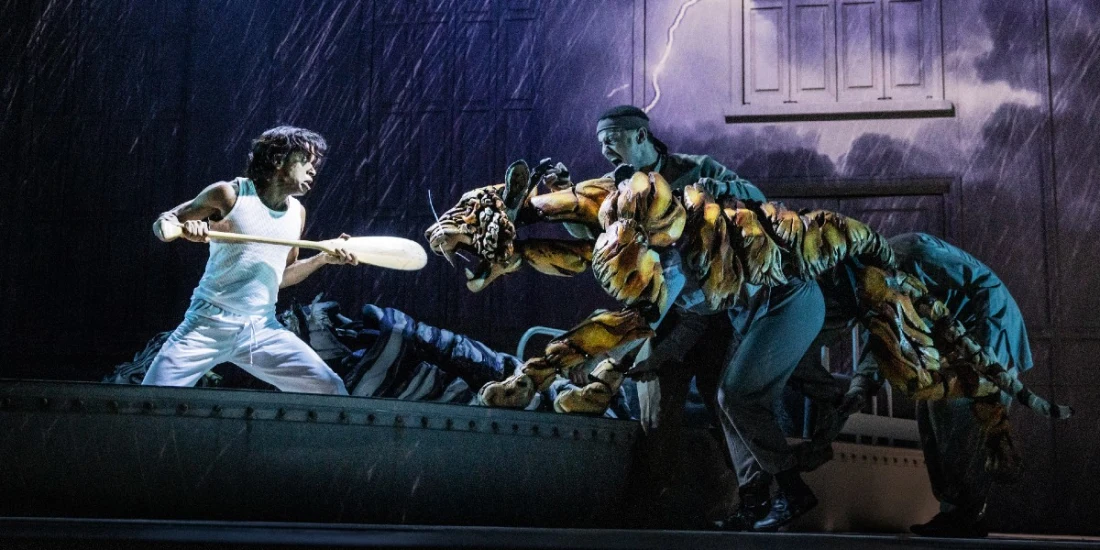How ‘Life of Pi’ found its roar on Broadway
The Tony-nominated design team and director of the adventure play talk about how the production design, including puppetry, transformed from London to Broadway.
The novel-turned-film-turned-play Life of Pi comes to life on stage with the help of lifelike puppets and immersive design elements that transport audiences from a zoo in Pondicherry, India, to the open waters of the Pacific Ocean to a Mexican hospital room.
The imaginative story follows 16-year-old Pi, the sole human survivor of a shipwreck, who must fend for himself while traversing the ocean in a lifeboat with a Bengal tiger, orangutan, zebra, and hyena. Their survival journey is mind-bending and magical.
In many ways, the story’s puppetry design — and stage success — hinged on Richard Parker, the tiger. Finn Caldwell and Nick Barnes, the show’s co-puppet designers, built a prototype for an early workshop informed by research on tigers’ muscular anatomy.
“We needed to know if it could move like a tiger — walk, jump on the edge of the boat, move around,” said Caldwell. “But the real question was, can we make the audience and the actor playing Pi actually frightened and scared?”
When the tiger prototype charged toward actor Hiran Abeysekera in rehearsal, and Abeysekera ran away in fear, the puppeteers knew they were on the right track. And while the puppet design may be the linchpin of the show’s magic, the set, costumes, and seamlessly integrated projection and lighting design are equally transportive.
The show first bowed at the Crucible Theatre in 2019 in Sheffield, England, before transferring to Wyndham’s Theatre in London’s West End in 2021. After winning five Olivier Awards, Lolita Chakrabarti’s stage adaptation made its way across the pond to Broadway in 2023, where it earned five Tony Award nominations, including for scenic design, lighting design, and costumes.

The Broadway transfer gave the cast and creative team the opportunity to make changes. "We were able to make some positive adjustments to the story based on the feedback from the West End," said director Max Webster, noting the first act was tightened.
The move also gave the deisgners the opportunity to expand the design elements of the show. “It is always good to get the opportunity to work on a show for a second (or third, or fourth...) time,” said scenic and costume designer Tim Hatley. “In my experience designing for theatre and film over the past 30 years, I have never walked away from a production thinking I have managed to get it all right.”
Most importantly, the design teams needed to adjust the scope and scale of the scenic design to fit the Gerald Schoenfeld Theatre in New York, which is wider and shallower than Wyndham’s. “This has, of course, had a knock-on effect, and video and lighting have had to adapt their designs to work with the new dimensions,” Hatley said.
For his part, video designer Andrzej Goulding (co-nominated with Hatley in the scenic design category) upgraded the show’s simulations. He also worked with lighting designer Tim Lutkin to recolor some scenes for the Broadway run and blend his projections, which naturally light the set, with Lutkin's lighting of the actors. The designers also had to adjust certain visual elements to accommodate different sight lines.
“The heart of the design is the ability to transition seamlessly from the hospital into Pi’s story, which is, for the most part, at sea,” said Hatley. The split-second transitions, which happen in full view of the audience, are integral to the narrative. “This was my challenge as the designer of the show, and I am pleased to have pulled it off.”

The puppets did not undergo a major transformation from London to New York, but the big question was whether Broadway audiences would be receptive to the animals, especially since shows involving puppetry are increasingly popular in British theatre and less mainstream in New York.
“Audiences have all been very positive towards the production," said Hatley. "I think the staging and the puppets make it stand out as something that is very different from a regular play. Audiences on both sides of the Atlantic have gone out of their way to congratulate me on the ingenuity of the designs.”
Webster agreed. "There is something very special in this story that touches people and that somehow resonated in a similar way in both countries... I feel a surge of excitement and gratitude every time I hear that roar at the end of the show and the audience stands up!"
Get Life of Pi tickets now.
*Photo credit: Hiran Abeysekera and Richard Parker (Fred Davis, Scarlet Wildernik, Andrew Wilson) in Life of Pi on Broadway. (Photo by Matthew Murphy & Evan Zimmerman for MurphyMade)
Originally published on

